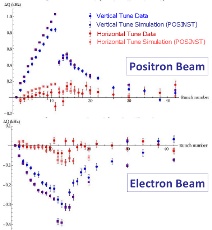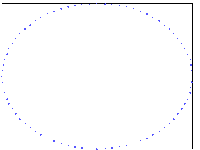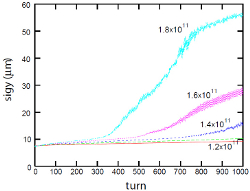In the beginning, there was... Susanna
A profile of Susanna Guiducci, ILC damping ring group leader

Susanna Guiducci, damping ring group leader. |
Susanna Guiducci has her head in the clouds – electron clouds, that is. (Sometimes she sits in clouds that gather around the Frascati hills south of Rome where she is based at the INFN Laboratori Nazionali di Frascati or LNF, but that is not really relevant to this story – just very picturesque.) As new leader of the damping ring group, one of the key R&D projects in the ILC’s Technical Design Phase, she also has her feet firmly planted in electron-positron accelerator physics and has been working on damping rings for ten years. All that experience gives her a clear picture of where the challenges lie in the ILC damping ring design, but she is confident: “I am convinced that the parameters set for the damping rings are feasible.”
Read more...
-- Barbara Warmbein |
 |
|
|
 |
(Almost) live from CesrTA

At Cornell, where the storage ring CESR is not only a particle physics project turned lightsource but also a test accelerator for the ILC damping rings, the team is in the middle of machine start-up. Above a picture from the control room during the January run (from left to right: Mike Billing, Robert Meller, Vildan Omanovic and Dmitry Teytelman). Below a figure showing tune shift data and simulations for electron and positron beams.

|
|
 |
 |
|
|
 |
Spring-scrubbing the beam pipe
How CERN’s accelerator complex fights electron clouds

Simulation of electron cloud build-up from proton bunches in the LHC. The animation shows results for ten subsequent bunch passages, during which the pictures become red. This simulation was done in 1997 by Oliver Brüning with the ECLOUD program for a maximum secondary emission yield of 1.7 without electron space charge. |
The ILC is not the only accelerator that has to struggle against electron clouds and their distracting effect on the particle beam. Even the Large Hadron Collider LHC at CERN may suffer from it, and tests on two of its pre-accelerators, the PS and the SPS, have already proven several techniques with which the electron-cloud build-up can be avoided or at least be brought under better control. One of those techniques is ‘scrubbing’, and it does what it says on the packet: it scrubs the beam pipe clean from the inside. It does not do this with bucket, cloth and detergent, however. Instead, a beam at the highest possible intensity, the limit of what the machines can take, is pumped through, literally getting hoovered by the vacuum pumps.
Read more...
-- Barbara Warmbein |
 |
|
|
 |
From Interactions
11 March 2009
Precision measurement of W boson mass portends stricter limits for Higgs particle
Scientists of the DZero collaboration at the Department of Energy's Fermi National Accelerator Laboratory have achieved the world's most precise measurement of the mass of the W boson by a single experiment.
Read more... |
|
From Fermilab
9 March 2009
Fermilab collider experiments discover rare single top quark
Batavia, Ill.–Scientists of the CDF and DZero collaborations at the Department of Energy’s Fermi National Accelerator Laboratory have observed particle collisions that produce single top quarks.
Read more... |
|
From Cern Bulletin
9 March 2009
Crystals against cancer
"This is a remarkable example of direct technology transfer from particle physics to medicine. Clinical trials have begun in Portugal on a new medical imaging system for the diagnosis of breast cancer, which uses positron emission tomography (PET)."
Read more... |
|
From Cern Bulletin
9 March 2009
The latest from the LHC
"Last week the Enhanced Quench Protection system had a full review from a panel made up of experts from other HEP labs from around the world, including the American laboratories FNAL and BNL, the German laboratory DESY and the ITER organization."
Read more... |
|
From DESY inForm
5 March 2009
FLASH tests ATCA
Telecommunications technology in the accelerator
Read more... |
|
|
 |
 |
|
|
 |
The ILC damping rings and electron cloud mitigation

Simulation of emittance growth from single-bunch instability driven by electron cloud in the 6.7-kilometre damping ring. Electron cloud densities in electrons per cubic metre are indicated. |
Today’s ILC Newsline is a thematic issue focusing on aspects of electron cloud mitigation for the ILC and for other future accelerators. One of the highest-priority goals of the ILC R&D programme during the Technical Design Phase is to demonstrate that the proposed mitigation techniques for the electron clouds in the damping rings will reduce the levels so that the clouds will not impact the emittance performance of the positron damping ring. Our damping ring group is a broad collaboration that has been run very capably by Andy Wolski (University of Liverpool/Cockcroft Institute) until recently. Susanna Guiducci (INFN – LNF) has now taken over coordination of that group and she is profiled in NewsLine this week. R&D on electron cloud effects is of importance for other future accelerators, not just for the ILC, and we also feature an article on electron cloud effects for other accelerator projects this week. In my column today, I briefly review the problem for ILC, as well as the status and plans for our R&D programme.
Read more...
-- Barry Barish
Director's Corner Archive |
 |
|
|
 |
|
arXiv preprints
0903.1616
FLASH Beam-Off RF Measurements and Analyses
0903.1608
Simulating Hard Rigid Bodies
0903.1383
Neutral Higgs Boson Pair-Production and Trilinear Self-Couplings in the MSSM at ILC and CLIC Energies
0903.1143
Top Quark Physics at the ILC: Methods and Meanings
0903.0804
Latest Beam Test Results of the FONT4 ILC Intra-train Feedback System Prototype
0903.0490
One-loop Electro-Weak Corrections to the Event Orientation of e+e- into 3 jet Processes
0903.0434
The Gamma-Gamma Interaction : A Critical Test of the Standard Model
0902.4830
New results for loop integrals: AMBRE, CSectors, hexagon
|
|

